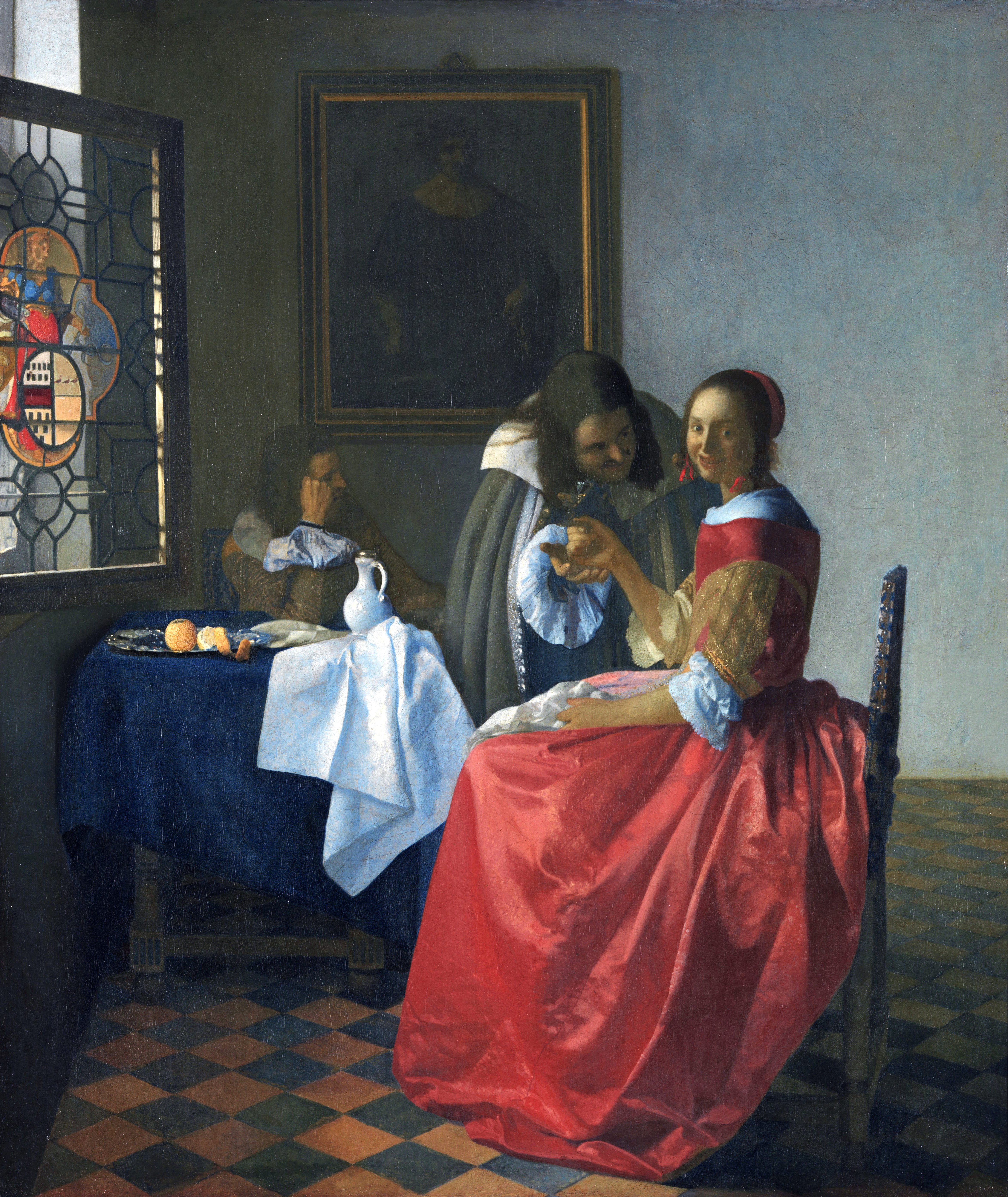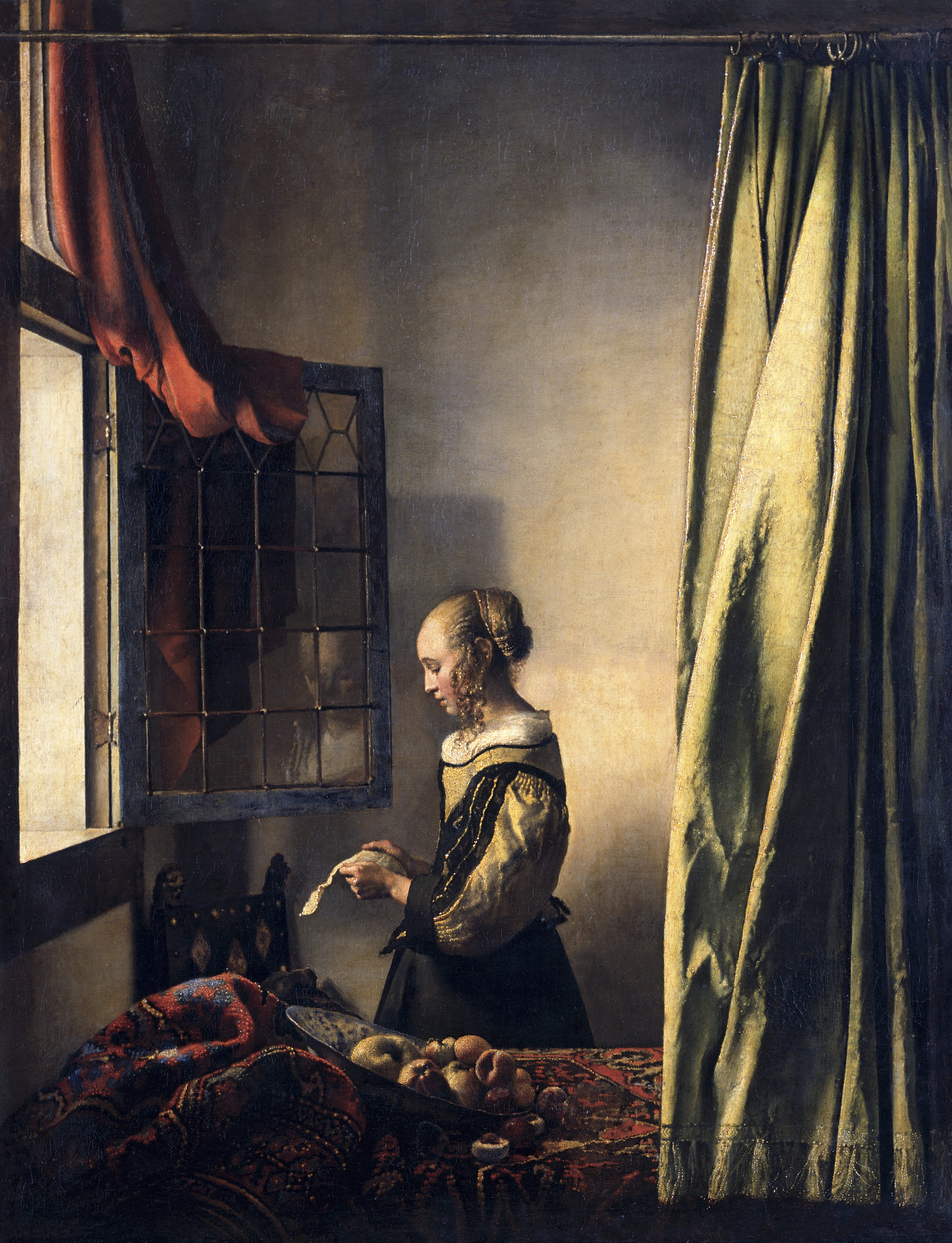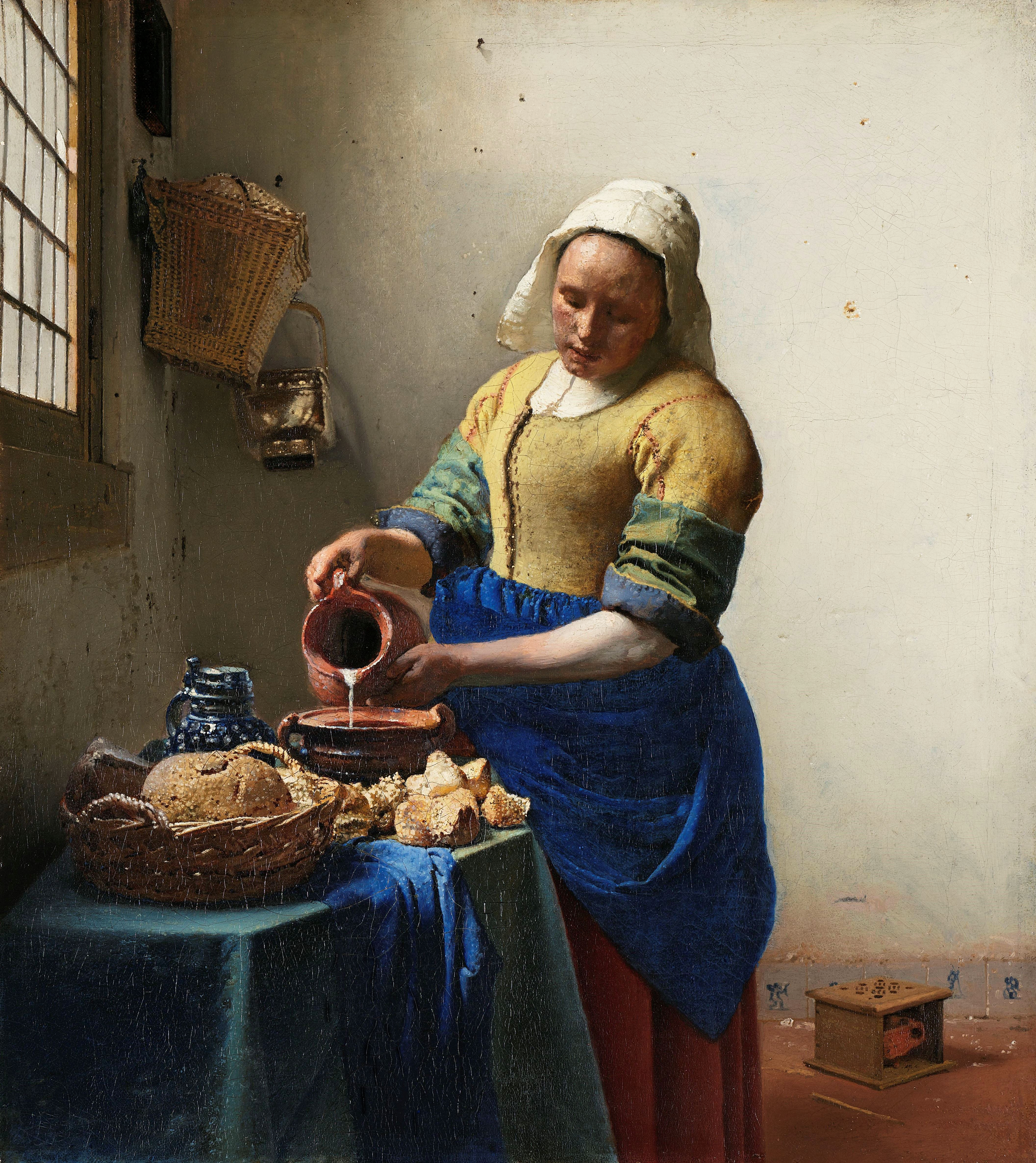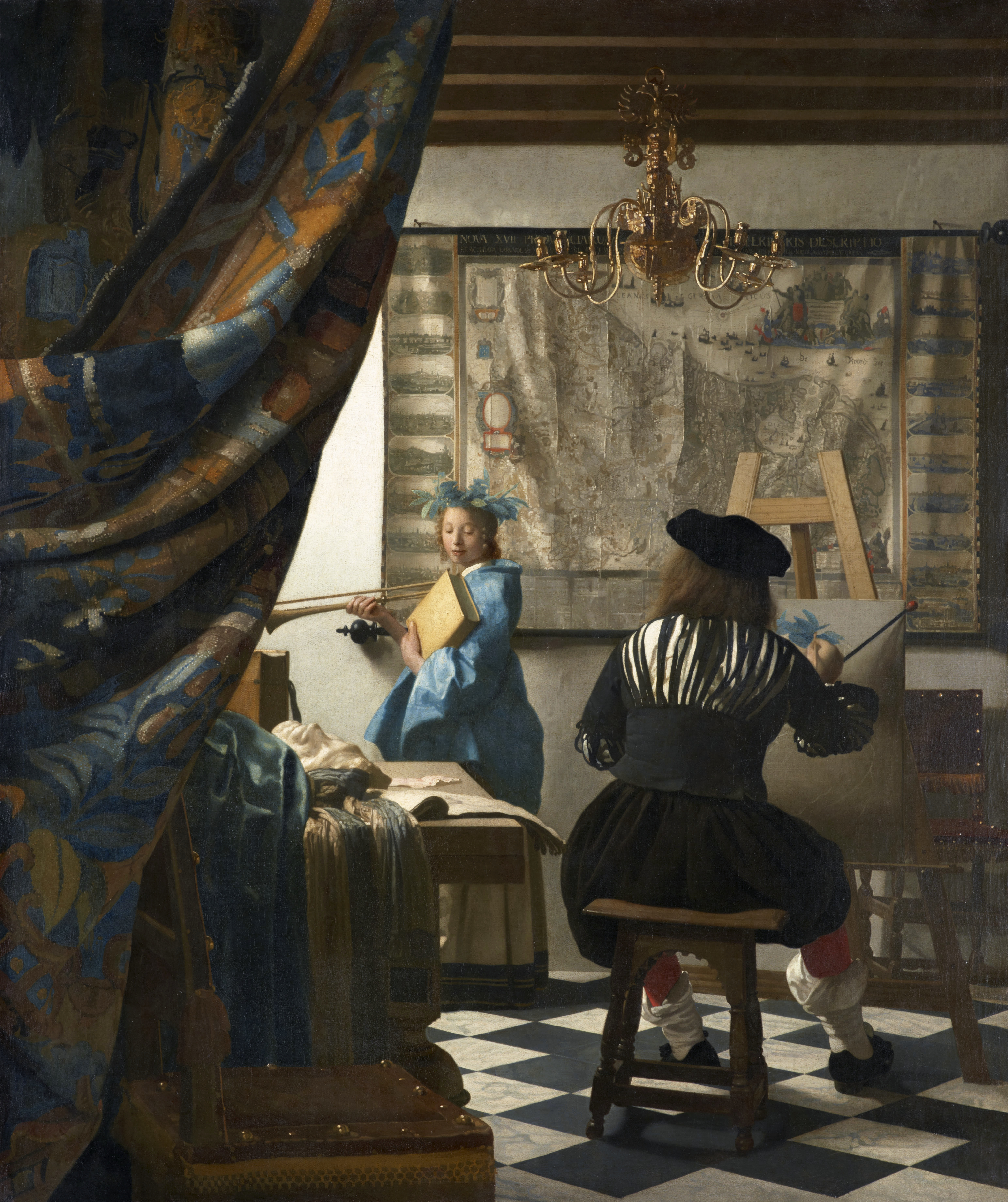Johannes Vermeer (1632–1675) was a painter who lived in Delft, the Netherlands, and pursued his entire career there. Although his output was relatively small, he is regarded as one of the foremost representatives of 17th-century Dutch painting due to his mastery in handling light and color.
Vermeer’s paintings are distinguished by their play of light—often thought to be related to optical observations—along with subtle compositions and symbolic associations. During his lifetime, he produced only a limited number of works, suffered financial hardship, and died at a young age. Forgotten for many years, he was rediscovered in the 19th century and has since been celebrated as one of the original masters of Western art.
Early Life and Education
Johannes Vermeer was born in Delft in 1632. His father ran an inn, occasionally worked in silk weaving, and also engaged in the art trade. When his father died in 1655, it is believed that Vermeer inherited the stock of artworks connected with the family’s business.
Growing up in Delft, Vermeer married Catherina Bolnes in 1653. Coming from a Catholic family, Catherina provided him with social and financial security, and the couple had eleven children. That same year, Vermeer joined the painters’ guild, gaining the status of an independent artist.
It is not known with certainty under which master Vermeer trained as an apprentice. However, the compositional order, use of light, and spatial design evident in his early works suggest that he drew inspiration from Delft’s artistic milieu. In particular, Carel Fabritius’s studies of perspective and light, as well as Pieter de Hooch’s domestic genre scenes, are thought to have influenced his development.
Artistic Career
On December 29, 1653, Johannes Vermeer was admitted to the Guild of Saint Luke in Delft, which gave him the right to practice as a painter. He later served as head of the guild in 1662, 1663, 1670, and 1671. His early works focused on large-scale religious and historical subjects; Christ in the House of Martha and Mary (1654–55) and Diana and Her Companions (mid-1650s) are examples of this phase. From the late 1650s onward, however, he increasingly turned to smaller interior scenes with one or a few figures, which became the hallmark of his art.
Vermeer’s known output is limited; only about thirty-five paintings survive today. When the French traveler Balthasar de Monconys visited Delft in 1663, he noted that he saw no paintings in Vermeer’s house, and remarked on the high price demanded for a work he encountered at a baker’s. A significant portion of Vermeer’s paintings were owned by the Delft collector Pieter van Ruijven.
The economic downturn of the 1670s, caused by war between the Netherlands and France, severely affected the art market. Vermeer’s income declined, he fell into debt, and he died in 1675. After his death, his paintings were dispersed among various collections; in a 1696 auction, twenty-one of his works were sold. Largely forgotten during the 18th century, his paintings were often attributed to other artists. In the 19th century, however, the French critic Théophile Thoré—especially moved by View of Delft—revived interest in Vermeer and restored him to his place in art history.
Technique and Style
Vermeer’s painting technique has been carefully studied in detail. He typically began his works with a brown monochrome sketch or a colored ground layer, establishing the outlines of the composition and the distribution of light and shadow. He then built up the painting with successive layers of paint.
His choice of pigments was remarkable for the time, often involving expensive and rare materials. Natural ultramarine derived from lapis lazuli, lead-tin yellow, madder lake, and various earth colors are frequently found in his paintings. By grinding these pigments to different degrees, he created surfaces that reflected light with varying intensity.

Use of Ultramarine Blue and Red The Girl with a Wineglass Johannes Vermeer (rawpixel)
Vermeer employed varied techniques in his surface handling. In some passages he applied paint in thin, translucent layers, while in others he used small, rounded, or dotted brushstrokes to create shimmering highlights. He developed these methods to evoke the play of light on pearls, metal, or fabric surfaces. Technical examinations have revealed his use of the pin-and-thread method in perspective construction; in certain paintings, pinholes can still be seen at central vanishing points.
Among the distinguishing features of his style are the harmony of light and space, the stillness of his figures, and their introspective demeanor. It is also thought that he was inspired by optical devices such as the camera obscura; effects resembling soft focus, light spots, and a heightened sense of depth are reflected in his works.
Iconography and Themes
The most common subjects in Vermeer’s paintings are female figures in domestic interiors. Women are often depicted reading or writing letters, making music, standing by a window, or engaged in household tasks. His letter-themed paintings correspond to the growing practice of letter writing in 17th-century Holland; such letters are generally interpreted as allusions to romantic relationships. Scenes portraying women making music involve instruments such as the lute, virginal, or viola da gamba. In the visual culture of the period, music was perceived as a metaphor carrying associations of love and harmony, as well as erotic undertones.

Girl Reading a Letter by an Open Window - Johannes Vermeer (rawpixel)
The artist’s repertoire also includes paintings with allegorical content. In The Art of Painting, the figure of the painter depicts Clio, the muse of History; the composition alludes to the power of art to shape history. In The Allegory of Faith, symbols drawn from Ripa’s Iconologia—such as the globe, serpent, Holy Scripture, and crucifix—are employed within the framework of Catholic iconography.
In addition, scenes of women adorning themselves before a mirror or attending to jewelry are linked to the Vanitas tradition, serving as reminders of the transience of worldly pleasures. Works such as The Milkmaid and The Lacemaker point instead to the virtues of women through representations of productive domestic labor.
Vermeer’s iconography is often multilayered; contemporary viewers could interpret these scenes through the lens of proverbs, emblematic books, and religious or moral references.

The Milkmaid - Johannes Vermeer (rawpixel)
Legacy and Influence
After Johannes Vermeer’s death in 1675, his remaining paintings stayed in the possession of his family, but due to financial difficulties they were quickly dispersed. In 1696, twenty-one of his works were offered for sale at an auction. During the 18th century, Vermeer’s name was largely forgotten, and many of his paintings circulated under the signatures of more renowned artists. For example, The Art of Painting was long attributed to Pieter de Hooch.

The Allegory of Painting - Johannes Vermeer (rawpixel)
Vermeer’s rediscovery took place in the 19th century through the efforts of the French critic Théophile Thoré. While traveling through Dutch museums in the 1840s, Thoré described the profound impression he experienced upon encountering View of Delft, and he began systematically tracing the artist’s other works. His biography and catalogue published in 1866 became a turning point in Vermeer’s recognition. Thoré’s writings attributed modern significance to Vermeer’s depictions of everyday life and his handling of light, situating him within contemporary debates on realism and impressionism.
In the 20th century, art historians turned their attention to Vermeer’s technique, especially his use of light and color. Optical effects associated with the camera obscura—such as soft focus, blurring, and spots of light—were reinterpreted as elements of his distinctive visual language. From the 1920s onward, with the rise of abstract art, the compositional structures and color harmonies of Vermeer’s paintings were increasingly emphasized.
Today, Vermeer is recognized as one of the foremost masters of 17th-century Dutch painting. His limited oeuvre is dispersed among major museum collections, and his paintings rank among the most studied and exhibited works of Western art.
Selected Works
- Christ in the House of Martha and Mary (1654–1655, Scottish National Gallery, Edinburgh)
- Diana and Her Companions (mid-1650s, Mauritshuis, The Hague)
- A Maid Asleep (1656–1657, Metropolitan Museum of Art, New York)
- Girl Reading a Letter at an Open Window (1659, Gemäldegalerie Alte Meister, Dresden)
- The Little Street (1658–1659, Rijksmuseum, Amsterdam)
- View of Delft (c. 1660, Mauritshuis, The Hague)
- Officer and Laughing Girl (1658–1659, Frick Collection, New York)
- The Milkmaid (1659–1660, Rijksmuseum, Amsterdam)
- The Concert (1660s, Isabella Stewart Gardner Museum, Boston)
- Lady Writing a Letter with her Maid (1660s, National Gallery of Ireland, Dublin)
- Girl with a Pearl Earring (c. 1665, Mauritshuis, The Hague)
- Girl with the Red Hat (c. 1665, National Gallery of Art, Washington, D.C.)
- The Art of Painting (c. 1665, Kunsthistorisches Museum, Vienna)
- Allegory of the Catholic Faith (1670s, Metropolitan Museum of Art, New York)
- The Astronomer (1668, Louvre, Paris)
- The Geographer (1669, Städel Museum, Frankfurt)
- Woman with a Guitar (1670s, Kenwood House, London)
- Lady Standing at a Virginal / Lady Seated at a Virginal (1670s, National Gallery, London)



